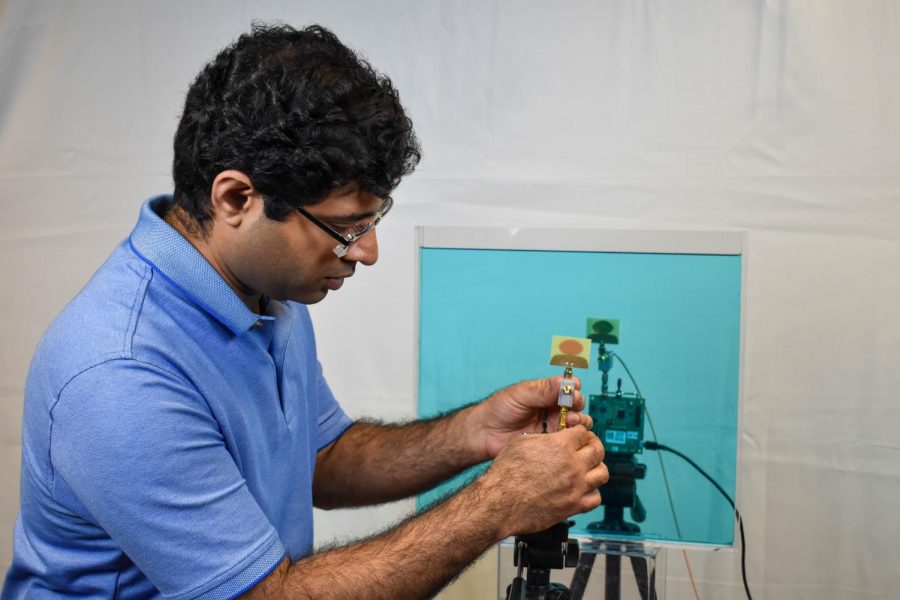New device identifies liquids
Photo courtesy of Coordinated Science Lab
Ashutosh Dhekne, graduate student in computer science, came up with the idea of innovating a device that can identify liquids, which could be especially useful in airports. He and a team have created the device and are further developing it.
Jan 28, 2019
A lot of people have experienced the dilemma of having to check their bags when flying since there is a strict limitation to the amount of liquid that can be brought on planes. However, this might change soon due to a recent study done at the University.
Researchers at the Coordinated Science Lab teamed up to develop a wireless-based technology with the potential to identify the difference between explosives and other liquids using wireless signals.
Ashutosh Dhekne, graduate student in computer science, said he came up with the project idea after noticing the lack of solutions when it comes to identifying liquids.
University of Illinois research could solve TSA’s 3 ounce restriction
Research allows for identifying liquids using wireless liquids
Get The Daily Illini in your inbox!
“The reason (to identify liquid) is important is, for example, at the airport. You cannot carry more than 3 ounces of liquid in your carry-on because you cannot just look at the bottle of liquid and tell if it contains some of the extreme alcoholic solutions or clean water,” Dhekne said. “As a result, airport security imposes strict restrictions.”
Dhekne said because of this, he and his team have been creating an instrument which can tell if a liquid is soluble or harmless water with one driving question: “Can we use wireless signals to start differentiating properties of materials?”
Haitham Hassanieh, assistant professor in Engineering, is part of the team and is the main collaborator in the project.
“Ashutosh runs the experiments and writes the codes. We mostly discuss and guide him to what to do and give him ideas when he gets stuck or when things are not working as well as they should be. So, basically, (we’re) generating ideas,” Hassanieh said.
Trying to determine every single liquid might be a concern when it comes to the speed in which the airports operate; however, Dhekne reassures the equipment will not be costly, which will allow airports to carry multiple of the technology and keep the process quick.
“You are not required to open any bottle, so you can carry sealed (bottles) which is an advantage,” Dhekne said. “When you have baby formula, for example, you have to show to TSA that you can open it, let them take a sample and test it through chemical analyzer. Once it’s over, you can carry it, which slows the process far more.”
Hassanieh said the physical and final aspect of the engine he has for now is presented as having two sensors. One sensor is on both sides and the other is in the middle, where you will put the bottle.
“One thing that we are thinking about is, can you have it in a form that the bottle does not need to be in between, rather than both sensors being at the same side. The difference is now the signal goes through, which makes it easier for us to do it, but on the other system (both sensors at the same side), the signals reflect and come back,” Hassanieh said.
The advantages of the project include practicality and accessibility for patrons, he said.
What makes this project unique, Hassanieh said, is its bilateral aspects. He said most work related to wireless is for the purpose of communication, but this project uses wireless for sensing and is designated as noninvasive.
“I can sense wireless signal or what’s going on,” he said. “They don’t require you to touch the liquids. Basically, if, for example, there is a dangerous liquid that you don’t want open, you can do it with sensors.”
Besides being used in airports, this upcoming technology can also be used in food safety, agriculture and health departments.
“Looking at the penetration, the reflecting index, we do have (an) application in healthcare that can benefit from this solution,” Dhekne said. “An example is you take a sample of blood, you pass the wireless signals into it, you’ll be able to determine if blood is anemic or not.”






